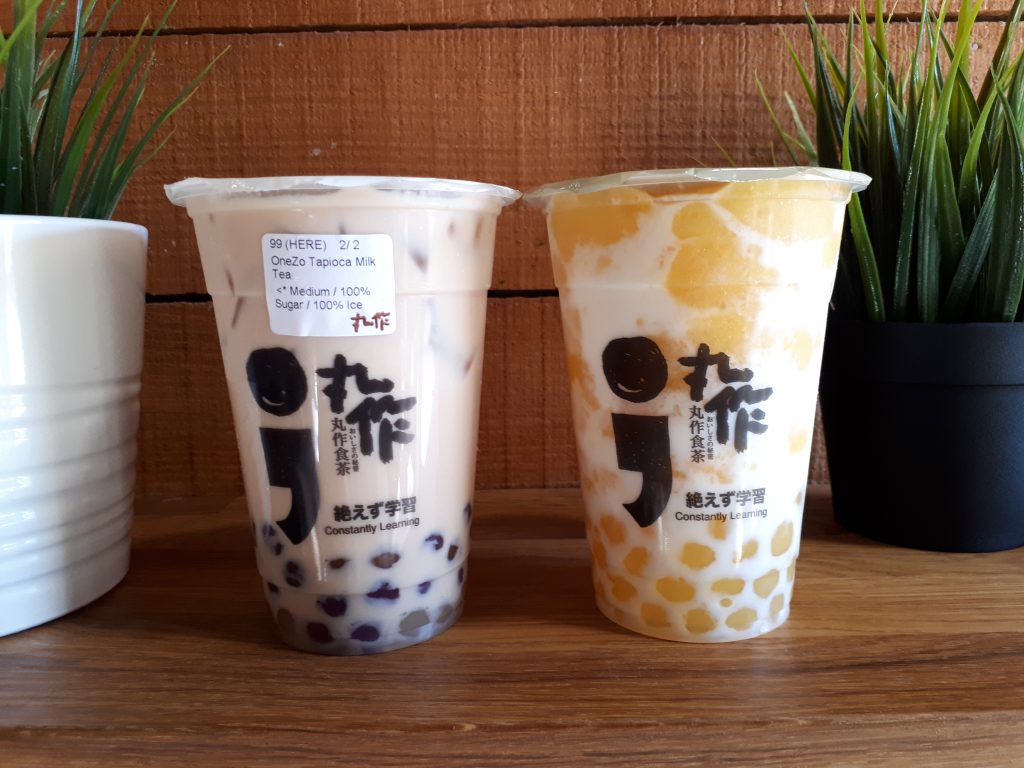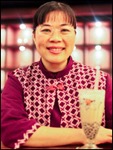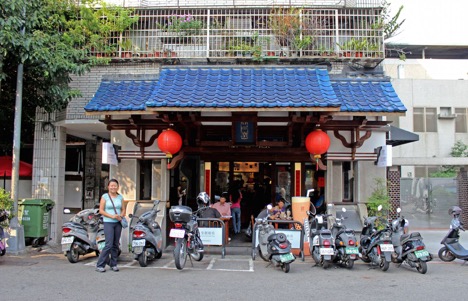
Two Varieties of Bubble Tea – Raehah Butt, 2018
A drink from Southeast Asia has popped up again in Toronto’s trendiest neighbourhoods, a decade after it first landed. Known as Taiwanese Boba or Bubble Tea, it begins with a base of cold tea, either black, green, or oolong. Then, distinctive “bubbles” — soft, chewy tapioca balls – plus other toppings, ranging from fruit flavouring (strawberry, mango, green apple, orange) and jelly cubes (“grass,” lychee, coconut) to red beans and ice cream are added at customer discretion. The resulting beverage, served cold in a plastic cup, handily ups the ante on indie coffee’s notorious customizability.
Raehah Butt
University of Toronto at Scarborough
To learn more about this cultural phenomenon, I explored three Toronto area bubble tea hubs: downtown Chinatown situated along Spadina, the growing suburban Chinatown at Finch and Midland in Scarborough, and the Yonge Street shopping district from Bloor to Dundas Square. Bubble tea has become popular through the reinvention and modernization of traditional Asian tea drinking, turning it into a youth-oriented experience with cross-cultural appeal that has been marketed both by global chains and diasporic entrepreneurs.
For most of their history, the Taiwanese prepared and consumed an indigenous variety of tea that remained distinctively local. Yet around the 1820s, migrants from Fujian province introduced Chinese tea seedlings to the island, which took root and flourished in migrant gardens over the course of the century. Then, in 1949, a group of Chinese nationals who had fled the Communist Revolution for Taiwan opened a series of highly regarded Tea Art Houses that served top-grade oolong tea brewed according to the Gongfu tea ceremony. It was out of one or perhaps two of these houses that bubble tea was invented, in the early 1980s. Two rival houses claim bubble tea as their own: Chun Shui Tang Cultural Tea House in Taichung City and Hanlin Tea House in Tainan City.
At first, the drink consisted of iced tea or iced milk tea with added fruit flavours that was shaken vigorously – the frothy top serving as the “bubbles” in the tea. Soon, a sweeter, highly caffeinated version became fashionable with Taiwanese students, which were often sold from small stalls strategically set up outside schools.
Bubble tea was changed forever on a fateful day in 1988, when Lin Hsiu Hui, a manager for Chun Shui Tang, added tapioca balls — a Taiwanese dessert topping also known as pearls — into her Assam milk tea during a staff meeting.
Made from tapioca flour, a starch derived from the culinary staple known alternatively as cassava, yuca, or manioc, the little machine-formed bubbles are boiled in water until they float, then simmered and left to cool in a sugar syrup, which gives them a soft, chewy texture. Hui’s adventurous idea became an overnight sensation, and hundreds of stalls and shops crowded local markets seeking to cash in on the craze and distinguish their products from rivals. Although tapioca pearls are originally white, Chun Shui Tang added brown sugar and food colouring to sweeten them make them highly visible in the beverage. Vendors heightened the bubble experience further by using oversized tapioca balls that required flashy, extra-wide straws. They even developed “bursting” boba: tapioca balls with a brittle fruit-flavoured center that explode when chewed.
Although Chun Shui Tang opted to stay as a traditional Taiwanese tea house, rivals began to franchise their brands, opening shops and stalls across the country as well as in mainland China, Japan, Korea, Malaysia, Indonesia, and eventually North America. Coco Fresh Tea and Juice claims to be the world’s largest bubble tea chain with over 2,000 stores worldwide. In Toronto and the surrounding area, there are more than 100 bubble tea shops, including a number of Taiwanese outlets such as Coco, Chatime, Gongcha, Share Tea, and Ten Ren. Having arrived in 2011, Chatime claims to have been the first authentic — meaning Taiwanese corporate — chain to open in the City.
Nevertheless, Torontonians picked up the bubble tea habit decades earlier as some enterprising members of the City’s Asian diaspora looked to cash in on the global phenomenon. The Green House Tea Room, founded in 1993, claims to have been the first to offer bubble tea and authentic Taiwanese food in Ontario. The company still operates many locations around the Greater Toronto Area under the new name of Green Grotto. Another early Canadian pioneer was Bubble Tease, which opened its first shop in 1997, and offers an eclectic range of foods, both North American nachos, waffles, and wings, as well as pan-Asian fish balls, edamame, and halo halo. Ontario’s leading chain is Real Fruit Bubble Tea, with more than thirty locations from Hamilton to Ottawa.
In comparing three hubs of bubble tea shops in Toronto — Spadina Chinatown, Finch and Midland, and Dundas Square — there are notable similarities in their composition and offerings even as they differ markedly in urban geography. All three zones include a mix of Taiwanese chains and home-grown Toronto businesses that offer both traditional Taiwanese cuisine and Americanized fusion dishes. In each zone, one finds busy stands that move customers through quickly and also sedate rooms where people linger over the drinks. Generally speaking, Taiwanese chains tend to operate small stands for take-out only, while the Canadian shops provide a more relaxed tea room atmosphere where customers can read magazines or play board games. The Spadina Chinatown offers the most abundant selection of bubble tea, as one might expect from such an established neighbourhood, with shops located near other restaurants in an effort to perhaps position the beverage as a snack or dessert following a meal. On Yonge Street, the bubble tea shops guide consumers through the busiest shopping spots in Toronto, from Bloor Street to Dundas Square and the Toronto Eaton Centre. Unlike the downtown shops, teahouses in Scarborough take advantage of low real estate prices and dense Asian populations to fill more spacious shops with larger seating areas.
Bubble tea has continued to evolve in the diaspora, with shop owners borrowing from popular North American snack brands. For example, Oreo cookies have become a popular “mix-in” for Toronto area shops such as Green Grotto, Gong Cha, Sharetea, Sugar Marmalade, and Latea Era. Meanwhile, Sharetea added sugar-coated breakfast cereals to create a “Cereal Bubble Tea Slush,” inspired by a dessert from the New York City restaurateur David Chang’s Momofuku Milk Bar. Promotional materials from Taiwanese branches of Sharetea, Gong Cha, do Coco not emphasize Oreo Milk tea and Cereal Slush, suggesting that they were created for North American market and have not caught on with Taiwanese consumers. Many new Taiwanese offerings have likewise failed to catch on in North America.
On the whole, bubble tea shop owners in Toronto have done a handy business by blending parallel insights into fashion trends in Taiwan and China, and North America. From traditional teas to soupy and colourful cereal drinks, proprietors cater to an array of migrant desires: some for a taste of home, others for a glimpse into hyper-typical North American childhood, but in portable format. And indeed, over time their products seem to be getting more western, with shops hoping to spark a modern tea culture for trend-setting youth and young adults with cash to spare. In carrying out this research, I have learned much about the social media usage of and the spaces of socialization created by diasporic youth with roots across the Asian continent. I also consumed a jittering amount of tea.
The research for this essay was supported by a University of Toronto Excellence Award.

